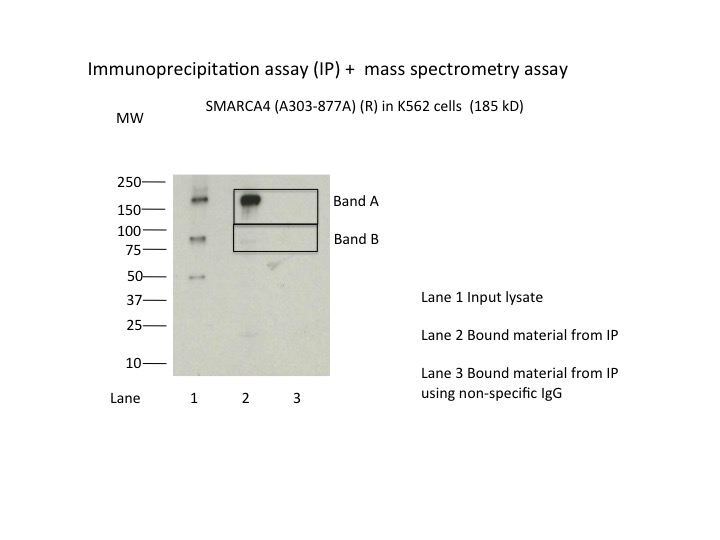ENCAB039LJW
Alternate accession: ENCAB723KTQ
Antibody against Homo sapiens SMARCA4
Homo sapiens
K562
characterized to standards
- Status
- released
- Source (vendor)
- Bethyl Labs
- Product ID
- A303-877A
- Lot ID
- 1
- Characterized targets
- SMARCA4 (Homo sapiens)
- Host
- goat
- Clonality
- polyclonal
- Purification
- affinity
- Isotype
- IgG
- Antigen description
- Component of SWI/SNF remodeling complexe with ATPase activity. Immunogen Between 50 and 100.
- Aliases
- michael-snyder:AS-1282, bradley-bernstein:PchAb 1240
- External resources
Characterizations
SMARCA4 (Homo sapiens)
K562
compliant
- Caption
- Immunoprecipitation was performed on nuclear extracts from the cell line: K562, using the antibody A303-877A. The blot shows western blot analysis of input, flowthrough, immunoprecipitate and mock immunoprecipitate using IgG.
- Submitted by
- Denis Salins
- Lab
- Michael Snyder, Stanford
- Grant
- U54HG006996
- Download
- 1047_10_SMARCA4_A300-877A.jpg
SMARCA4 (Homo sapiens)
K562
compliant
- Caption
- Immunoprecipitation was performed on nuclear extracts from the cell line K562 using the antibody A303-877A. Lane 1: input nuclear lysate. Lane 2: material immunoprecipitated with antibody. Lane 3: material immunoprecipitated using control IgG. Marked bands were excised from gel and subjected to analysis by mass spectrometry. Target molecular weight: 184.646.
- Submitted by
- Nathaniel Watson
- Lab
- Michael Snyder, Stanford
- Grant
- U54HG006996
SMARCA4 (Homo sapiens)
Method: immunoprecipitation followed by mass spectrometry
compliant
- Caption
- IP followed by mass spectrometry. Briefly, protein was immunoprecipitated from K562 nuclear cell lysates using the antibody A303-877A, and the IP fraction was loaded on a 10% polyacrylamide gel (NuPAGEBis-Tris Gel) and separated with an Invitrogen NuPAGE electrophoresis system. The gel was stained by ColloidialCoomassie G-250 stain, gel fragments corresponding to the bands indicated were excised. Then proteins were trypsinized using the in-gel digestion method. Digested proteins were analyzed on an Orbitrap Elite mass spectrometer (Thermo Scientific) by the nanoLC-ESI-MS/MS technique. Peptides were identified by the SEQUEST algorithm and filtered with a high confidence threshold (Peptide false discovery rate < 1%, 2 unique peptides per protein minimum, mass error < 10 ppm).
- Submitted by
- Nathaniel Watson
- Lab
- Michael Snyder, Stanford
- Grant
- U54HG006996

